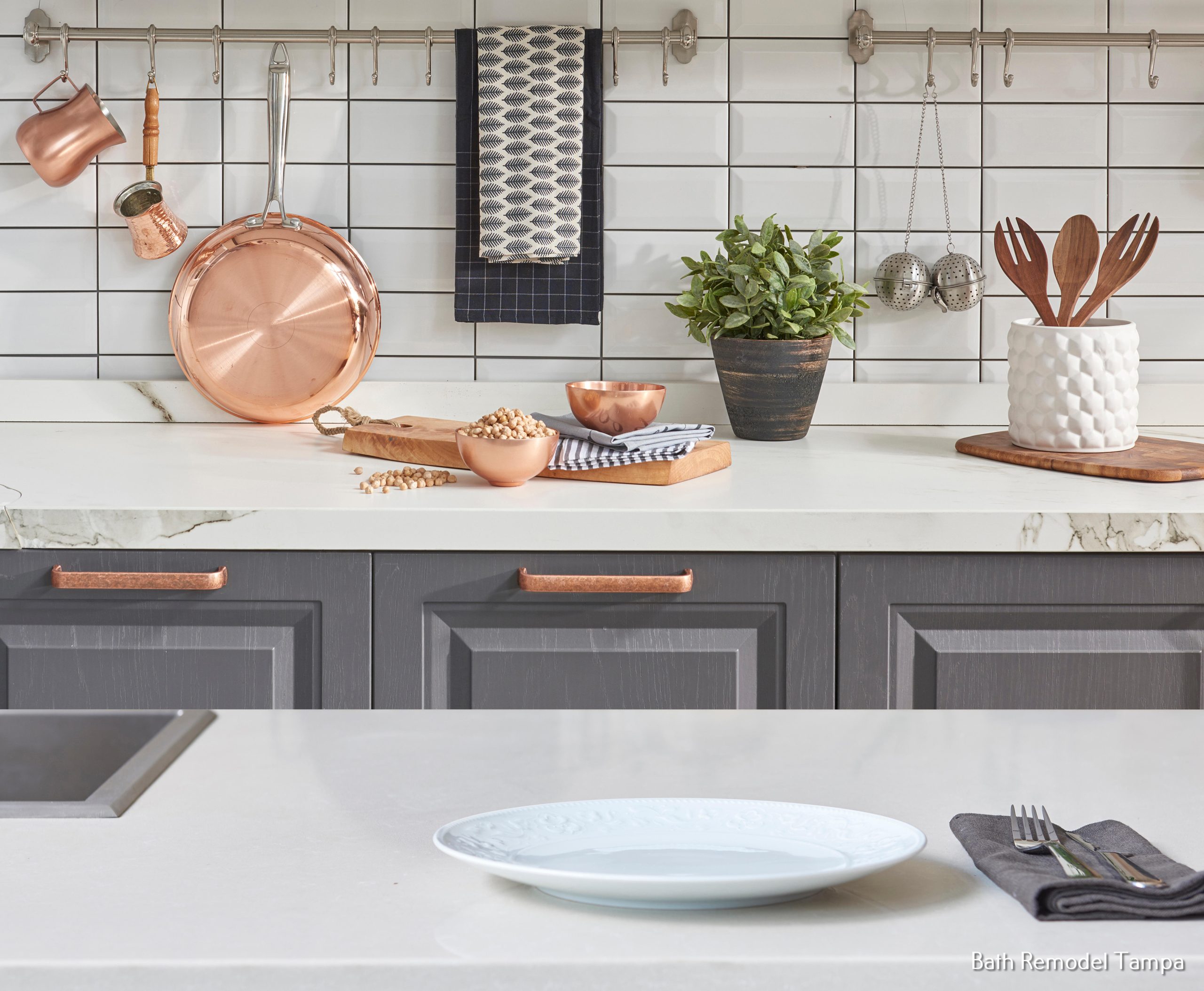
Sustainable Kitchen Remodeling: Why You Should Make the Switch
Do you dream of remodeling your kitchen but cringe at the thought of all the extra waste created by your renovation? If so, now is the time to make the switch to sustainable kitchen remodeling and create a space that’s more eco-friendly. Sustainable remodeling puts the environment first and makes thoughtful choices when it comes to sourcing materials and discarding waste. It may cost a bit extra in the short term, but the benefits will last for years and years and create a healthier home for everyone. Read on to discover why you should make the switch to sustainable kitchen remodeling and how it can be achieved today.
What is a sustainable kitchen remodel?
When it comes to sustainable kitchen remodeling, debate arises over whether or not this sort of home renovation will benefit one’s home and lifestyle. A sustainable kitchen design and renovation can be defined as any sort of alteration meant to make use of environmentally friendly building materials while improving the efficiency of energy use. This means that while undergoing a sustainable kitchen renovation, people have the ability to reuse existing materials, such as cabinets and sinks, while also making sure that new materials are resourceful, efficient, and recycled where possible.
The two sides to this argument are those who believe that sustainable kitchen design and renovation are the way to go—improving efficiency of energy use, lessening water waste, aiding in the reduction of environmental footprints, and increasing your home value—and those who do not think investments in sustainable solutions are necessarily worth the extra money spent. While a traditional kitchen design and renovation can take up lots of energy resources for installation procedures like painting, sanding, or burning off old finishes, it typically does not promote more efficient use. Sustainable renovations, on the other hand, allow greater control over materials used and repairs made throughout the remodeling process, which all serve to help you lower your energy bills over time for a more efficient home.
In addition to saving money in the long run, opting for more resourceful solutions when remodeling kitchens, such as Energy Star-certified appliances and low-flow plumbing fixtures like toilets and faucets, which reduce drinking water waste by as much as 20% compared to pre-1994 models, encourages responsible consumption of energy. By investing in solutions like these with a certified green professional to help guide you through the process, you can help decrease our collective environmental footprint on top of the higher resale values that come with owning an eco-friendly space.
All in all, whether you choose a sustainable kitchen design and renovation or not depends on your own budget constraints, but there is certainly potential for improvement in terms of energy efficiency when going green. And with benefits like improved value and enhanced environmental responsibility that come with taking such steps towards sustaining our resources, no one should walk away from such an opportunity without at least considering it first. Making the switch to greener solutions doesn’t have to break the bank either; transitioning into this style of renovation is easier than ever when done correctly, making the choice to prioritize sustainability when renovating your kitchen an easy one. In this article, we will dive deeper into why these changes might be beneficial, but let’s begin by understanding why they’re important before addressing what effects they can produce later on.
Benefits of a Sustainable Kitchen Remodel
A sustainable kitchen design and renovation offers numerous benefits to homeowners and could be the start of a larger commitment to green living. For one, it can be an aesthetically pleasing design option; colors, patterns, and materials associated with sustainable remodeling tend to incorporate the natural world in all its splendor. Bamboo cabinets, natural stone countertops, recycled glass tiles—these are only some of the ways homeowners can enrich both the look and feel of their space without sacrificing their commitment to environmental consciousness.
Moreover, sustainable kitchen design and renovation are applauded for being cost-effective due to the use of recyclable and renewable materials; this may contribute to reductions in waste production and the creation of toxins normally associated with conventional building materials. Homeowners may also experience financial incentives from the local government should they choose a green kitchen renovation project. In addition to this economic perk, a sustainable kitchen design and renovation may add value to your home if you choose to sell it in the future due to its eco-friendly appeal.
Unquestionably, many debate whether a sustainable kitchen design and renovation is truly worth it or not. Arguments against eco-friendly materials often focus on the higher upfront costs associated with them compared to traditional options. Moreover, those who contend that any kind of home upgrade increases energy efficiency must also contend with structural limitations; even the most energy-efficient technology will struggle in an uninsulated home built decades ago. Finding ways to address these existing issues should be taken into account before investing in green construction methods, as certain components of your home have a greater impact than others on energy conservation efforts.
At the end of the day, capitalizing on the benefits associated with a sustainable kitchen design and renovation could be just what a homeowner needs when looking for ways to reduce their environmental footprint while adding value to their home and wallet alike. By doing so, homeowners allow themselves to take that next step towards creating a more sustainable lifestyle and understanding their daily habits’ impact on our environment—a link between cause and effect that can ripple far beyond our homes when we make conscious choices in our actions. With this understanding comes an appreciation for how far we can go once we incorporate just one area of sustainability into our lives. So let’s get going! Let’s explore how transitioning our kitchens towards sustainability affects our environment more broadly.
Environmental Impact
Making the switch to a sustainable kitchen design and renovation is beneficial in many ways, and one major benefit in particular lies in its ability to reduce the impact on our environment. By choosing eco-friendly alternatives to traditional materials, homeowners can reduce their carbon footprint and contribute to a healthier planet.
For example, products made from reclaimed wood are an excellent option for creating beautiful countertops or flooring that also have minimal environmental impact. Reclaimed wood holds up well against wear and tear, and because it has already been used up to three times before being available for purchase, using it in your kitchen reduces both the need for harvesting new lumber as well as the emissions created during the transport of new lumber.
In addition, ecological paints, varnishes, and finishes contain fewer toxic substances than their traditional equivalents, so they not only reduce harm to the environment outside our homes but also within them. They are often made with natural ingredients without VOCs (volatile organic compounds), which means fewer pollutants in our indoor air. Lavender extract can be used to keep pests away instead of harsh chemicals. Alternatives such as solar power offer greener options and even energy savings.
Switching to sustainable materials goes beyond just the environmental benefits they have to offer; they’re also becoming increasingly popular due to the growing trend of eco-consciousness amongst consumers. Making environmentally friendly choices is no longer simply ‘the right thing to do”; now more people than ever are conscious of how their actions can lead to positive change, and this shift is reflected in kitchen remodeling projects across the country. By making an effort to make your kitchen design and renovation environmentally friendly, you will not only contribute positively to our planet but also stay ahead of current trends.
As eco-consciousness increases year after year, so does the availability of sustainable products such as those discussed above. It is now more feasible than ever before for homeowners embarking on a kitchen design and renovation project to actively choose green building materials during their process, something that wasn’t always possible in years past. With more options available than ever before, it would serve as a great benefit for you and our planet alike if you decided to switch over your next kitchen project to a sustainable one—but why stop there? Everything from bathroom vanities to lighting fixtures can be switched towards sustainability without sacrificing quality or aesthetic appeal! The possibilities are endless when it comes to going green; all you have to do is make the commitment and be conscious of the choices you make
Increase in eco-consciousness
Amidst global concerns, people’s interest in eco-consciousness has rapidly increased over the years. Although sustainable remodeling may be more costly in the beginning, its long-term benefits outweigh the costs. In investing in sustainable kitchen design and renovation, the materials used have a much lower impact on the environment, thus not contributing as heavily to pollution and climate change. Furthermore, renewable materials such as organic wool insulation also reduce energy costs, which further helps reduce one’s carbon footprint.
On the other hand, while many may argue that traditional remodeling with conventional materials is cheaper, natural resources maintain their value and can increase property values in certain situations, such as when selling a home or building. However, it is often difficult to measure potential health benefits from small changes, and most of us would agree that we should always prioritize our well-being before profit margins.
Therefore, an important part of ensuring greater sustainability starts at home by incorporating eco-friendly practices into our everyday lives. Aside from being conscious of what we buy and consume, investing in sustainable design solutions for our kitchens is an easy way to actively promote the preservation of natural resources. Allowing us to not only save money but also help protect the planet for future generations.
The next step in sustainable kitchen remodeling is to increase efficiency by making smarter decisions that will pay off over time. This includes options such as installing energy-efficient appliances and using new ideas like automatic water turn-off devices, which can help prevent excess water waste without compromising convenience.
Improved Efficiency
The increased awareness of environmental impacts has had a positive effect on the redesign of kitchens worldwide, with efficiency being one definite improvement. When remodeling sustainably, homeowners have the ability to upgrade their appliances and features that will enhance the energy and water efficiency of that particular kitchen. From upgrading to high-efficiency appliances to even something as small as insulating inner cabinet walls, making these green changes allows for improved performance in energy and water usage.
Proponents argue that efficiency upgrades benefit the environment by curbing emissions from utilities and, in turn, increasing the lifespan of old houses by allowing them to remain functional with little or no major renovations or repairs over time. Many homeowners tend to opt for more efficient lighting sources such as LED while remodeling sustainably, as they have the potential to deliver up to 80% savings in electricity compared to older lighting sources like incandescents, halogens, and other conventional bulbs.
Opponents counter that making green changes can be expensive initially due to necessary purchases such as appliances and insulation materials, along with installation fees. However, this argument is not entirely strong, mainly because homeowners often end up saving money in the long run due to the increased number of years that each individual appliance lasts and fewer utility bills owed throughout the year. Additionally, with incentive programs provided by local governments and even some corporations and organizations, it can oftentimes help offset or subsidize these expenses associated with green renovations.
Striving for greater sustainability without sacrificing comfort or style is becoming easier than ever for kitchen design and renovation. Making green improvements, such as replacing outdated appliances, is one way to ensure efficient energy use without compromising functionality within the kitchen space. Adopting renewable resources and materials into the kitchen design is another way homeowners can further upgrade their sustainable kitchen renovation experience.
Renewable Resources and Materials Used
Making the switch to a sustainable kitchen design and renovation can also involve adding renewable resources and materials. While there is a benefit to improved efficiency, renewable resources come with added economic and environmental benefits by reducing the reliance on finite natural resources. When looking for new materials or appliances, opt for ones that are made from renewable resources like bamboo, wool, or cork. These materials resist water and humidity without requiring harsh treatments and could significantly reduce energy consumption.
Moreover, as long-term investments, they last longer and require fewer chemical treatments than other materials. Consider replacing outdated water-hungry toilets with low-flush options or replacing your old energy-inefficient dishwasher with a modern energy-efficient model that uses less water (and time) to complete a cycle.
The kitchen is the ideal room to explore innovative ideas to improve its sustainability. From clever storage solutions made of renewable materials to resourceful appliances that can save energy, these choices will have long-term implications not only for energy savings but for our environment as well. However, when remodeling the kitchen, be sure to keep all factors in mind— this includes considering budgets, designs, and what features best suit your lifestyle—as it is essential to make an informed decision prior to beginning any renovations.
Factors to Consider When Planning a Sustainable Kitchen Remodel
When planning a sustainable kitchen remodel, there are many factors to consider. While renewable resources and materials should be used to their fullest potential, homeowners must ensure that their remodels are also financially accessible and still meet their aesthetic needs. This can be a tricky balance to find, as renovating with more sustainable materials often requires more time or money.
Whether it is worth investing in more expensive and exotically sourced materials depends largely on several factors, like how long the homeowner intends to stay in the home, the availability of local suppliers, and whether the homeowner is comfortable making concessions on functionality or design for the sake of sustainability. For example, if someone plans on staying in the house for a long period of time, it may be financially savvy to invest in higher-quality and longer-lasting sustainable materials over cheaper products that might last five years or less. On the other hand, if someone only intends on being there for a short while or needs to save money due to tight budget restrictions, opting for non-renewable but cheap options may make more sense.
Additionally, before taking the plunge into a sustainable kitchen remodel, homeowners must think about their own individual priorities in terms of aesthetics and design. Just because something is sustainable does not necessarily mean it will fit perfectly with one’s desired look. Countertops made from recycled glass or bamboo cutting boards may cost more than their conventional counterparts but could undermine one’s idea of an attractive kitchen. Thus, gentle compromises between style and sustainability should be considered before committing to any materials or products.
With careful consideration of these factors before beginning a sustainable kitchen design and renovation project, homeowners will be able to create beautiful and eco-friendly kitchens that stand the test of both time and trends. As such, they can then move towards finding a qualified designer to bring their vision to fruition.
How to Find a Sustainable Designer for Your Kitchen Remodel
When it comes to finding a sustainable designer for your kitchen remodel, there are many factors to consider. A sustainable kitchen design and renovation requires quality materials and careful planning, making it essential to select a designer who has experience in this type of renovation. Fortunately, there are a few ways you can go about finding the right designer for you.
One of the best ways to find a good sustainable designer is to read reviews from past customers. This will help you get an idea of the designer’s experience with sustainability-focused renovations and provide insight into their customer service and results. Since customer feedback is often unbiased, it can be a great way to ensure trustworthiness and peace of mind in your decision.
Another approach is to ask for recommendations and referrals from friends, family members, or other contacts within the industry. If someone you know has used a particular designer for their own remodels, they might be able to provide helpful information about that individual or company. Moreover, asking neighbors or other sustainability experts in your area can also give you valuable insights into which designers focus on using environmentally friendly materials and practices.
Finally, if none of these methods yields any useful leads or contacts, you can always search online for sustainable designers in your city or state. Social media sites such as Instagram and Facebook are full of user reviews and ratings of people’s experiences working with different sustainable professionals, so take advantage of that resource when searching online as well.
In the end, deciding on a sustainable designer for your kitchen design and renovation ultimately comes down to personal preference and comfort level. It is important to do your research beforehand to examine factors like credentials, reviews, qualifications, and professionalism; this way, you can better understand what kind of services each potential designer provides before making your final decision.
Frequently Asked Questions and Answers
What are the costs associated with a sustainable kitchen remodel?
The costs associated with a sustainable kitchen design and renovation depend on the size of the project and the materials used. Generally, homeowners should expect to spend anywhere from 10 to 50 percent more on conventional remodeling projects. The initial investment may be higher, but the long-term savings and benefits make this a cost-effective option in the long run.
For example, energy efficiency upgrades such as LED lighting or Energy Star appliances are likely to save you money on your utility bills. Additionally, sustainable materials like bamboo cabinets or flooring require less maintenance and last much longer than their conventional counterparts, resulting in further cost savings over time. Finally, by using recycled or locally sourced materials, you can help support local businesses and reduce your environmental footprint.
What are some of the benefits of sustainable kitchen remodeling?
Sustainable kitchen remodeling offers a variety of benefits, both to our environment and to our budget.
First and foremost, investing in eco-friendly materials can help reduce your overall carbon footprint. By using materials such as bamboo countertops, recycled glass tiles, or low-VOC paints and sealants, you can rest assured that you’re making a conscious effort to reduce your impact on the environment. And since these materials tend to be an investment rather than just a one-off purchase, you’ll find yourself reaping rewards for years to come.
Additionally, sustainable kitchen remodeling can provide substantial savings on utilities over time. For example, installing natural ventilation systems can help reduce heating and cooling costs by managing air flow. Likewise, choosing energy-efficient lighting fixtures and appliances can lead to lower energy bills each month. Publishing studies have also found that people who make smart eco-investments enjoy healthier lives with cleaner indoor air, saving even more money in the long run on health care costs.
Finally, going green in the kitchen gives the homeowner a sense of pride. Sustainability efforts don’t just make financial sense—they also create a sense of accomplishment that’s hard to put into words. Our decisions today have an immense global impact on future generations, so investing in sustainability is both beautiful and rewarding—in more ways than one.
What type of materials should be used when remodeling a kitchen sustainably?
When remodeling a kitchen sustainably, it’s important to use materials that are friendly to the environment and conserve resources. Some great options for sustainable kitchen design and renovation materials are recycled materials such as wood, glass, metals, stones, or other natural products made from sustainable sources. For cabinetry and countertops, recycled wood is a durable and attractive option. Reclaimed wood has character and looks great with natural stone tiles for flooring. Cork flooring is also a great sustainable option since it can help insulate your kitchen and save energy in the long run.
For countertops, look for reconstituted stone slabs, which release fewer toxins than natural stone surfaces like granite or marble. Another great option for a countertop material is bamboo or even resins derived from plant-based sources, as they are renewable and biodegradable. Lastly, using eco-friendly paints, such as those with low VOCs (volatile organic compounds) or zero VOCs, can help reduce indoor air pollutants.
Overall, when considering what type of materials to use for a sustainable kitchen remodel, look for items that have minimal impact on the environment and natural resources. Reclaimed wood and other recycled materials are excellent options because they save energy and resources while offering timeless beauty for your home. Other materials like cork floors, plant-based resins, and eco-friendly paints can also boost your kitchen’s sustainability without sacrificing style or quality.
Trusted Kitchen Remodeling Contractor in Tampa, FL
Are you ready to transform your kitchen into a stunning and functional space that perfectly suits your style and needs? Look no further than Revive Design and Renovation, the trusted kitchen remodeling contractor in Tampa, FL. Our team of skilled professionals is dedicated to delivering exceptional results, from concept to completion. With our expertise in design, craftsmanship, and attention to detail, we’ll bring your vision to life and create a kitchen that exceeds your expectations. Don’t settle for anything less than the best. Contact Revive Design and Renovation today and let us revitalize your kitchen into the masterpiece you deserve. Your dream kitchen is just a call away!







































